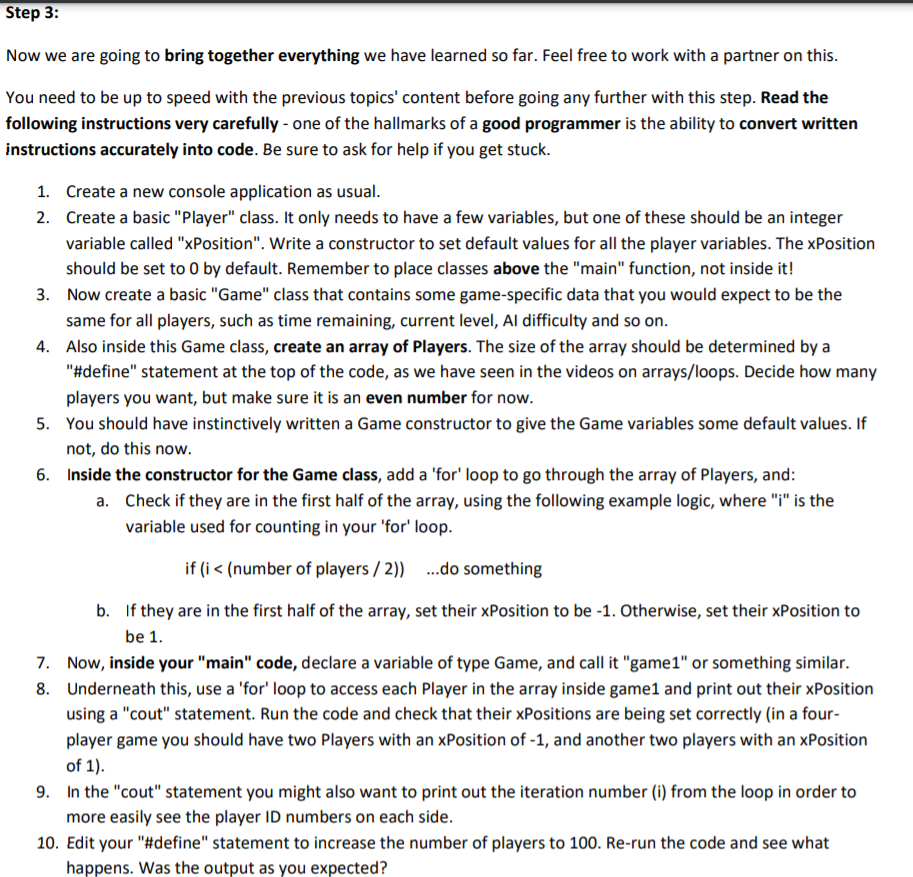TOGA Consolidation Week: Crocodile Simulator
- miketfkee
- Nov 16, 2020
- 4 min read
Updated: Nov 21, 2020
For TOGA Consolidation Week, we were given a C++ file in text and asked to decipher what it did without running the code.
The first bit of code:
class Position
{
public:
int x;
int y;
// constructor to set up default position...
Position()
{
x = 3;
y = 3;
}
};This class set up 2 integers to act as the x and y coordinates and set them both to 3 by default.
class Player
{
public:
string playerName;
int crocFood;
Position pos; // we are using our Position class for the player's x/y
// player constructor...
Player()
{
// default values here...
playerName = "default player name";
crocFood = 0;
}
};
This class sets up a Player with a string for the name, an integer for a as-of-yet unknown "item"(crocFood), and a position (calling the previously set up Position class) which would be set to (3,3) by default. The player is given a default player name and the amount of crocFood they have is set to 0.
int main()
{
// create an actual player...
Player player1;
// get some basic info...
cout << "Welcome, player, to Crocodile Simulator. Please enter your name: " << endl;
cin >> player1.playerName;
cout << "Very well " << player1.playerName << ", how many grams of croc food are you carrying? " << endl;
cin >> player1.crocFood;
cout << "Good. Let's get cracking. If you wander too far, you'll be attacked by crocodiles!" << endl;
// while the player is in the "safe zone"...
while ((player1.pos.x > 0) && (player1.pos.x < 6) && (player1.pos.y > 0) && (player1.pos.y < 6))
{
// show the player where they are...
cout << "Your current coordinates are (x = " << player1.pos.x << ", y = " << player1.pos.y << ")." << endl;
// if they are near the crocodiles, give them an additional warning...
if ((player1.pos.x == 1) || (player1.pos.x == 5) || (player1.pos.y == 1) || (player1.pos.y == 5))
cout << "Be careful, you are near the edge of the safe zone!" << endl;
// then prompt them for their next move...
cout << "Which way do you want to go (n/s/e/w)?" << endl;
char answer;
cin >> answer;
// check their response...
switch (answer)
{
// if they said north...
case 'n':
player1.pos.y = (player1.pos.y - 1); // move them north
break;
// if they said south...
case 's':
player1.pos.y = (player1.pos.y + 1); // move them south
break;
// if they said east...
case 'e':
player1.pos.x = (player1.pos.x + 1); // move them east
break;
// if they said west...
case 'w':
player1.pos.x = (player1.pos.x - 1); // move them west
break;
// if they said anything else...
default:
cout << "Please enter a valid direction!" << endl; // error message
break;
}
// end of "switch" statement
}
// end of "while loop": go back to the top of the loop and check again if player is still in the safe zone
// so if we ever get to this point, they must have wandered outside of the safe zone...
cout << player1.playerName << ", you have wandered too far and have been attacked by crocodiles." << endl;
// but do they actually die?
if (player1.crocFood > 1000)
{
cout << "Luckily, you have enough croc food to distract them while you escape!" << endl;
cout << "YOU WIN THE GAME." << endl;
}
else
{
cout << "Due to a distinct lack of croc food, they have you for dinner instead!" << endl;
cout << "YOU LOSE." << endl;
}
// exit game...
return 0;
}
Now the main chunk of code. First, the game asks the user for a player name, and a number to denote how much crocFood they have. The game then outputs a message to confirm both user inputs have been accepted and enters the game.
Next, the very large while loop will run as long as the player's X coordinate is within 1 and 5 (player1.pos.x > 0) && (player1.pos.x < 6) and their Y coordinate is also within 1 and 5 (player1.pos.y > 0) && (player1.pos.y < 6). As long as the coordinates are within the boundaries, the following code will run.
The code then outputs a line saying where the player's coordinates are [cout << "Your current coordinates are (x = " << player1.pos.x << ", y = " << player1.pos.y << ")." << endl;]. If the player's coordinates are on either the X or Y boundaries, an extra line of text is outputted to warn the player [if ((player1.pos.x == 1) || (player1.pos.x == 5) || (player1.pos.y == 1) || (player1.pos.y == 5)) cout << "Be careful, you are near the edge of the safe zone!" << endl;]
Next, the code asks the user for an input on which direction to go.
cout << "Which way do you want to go (n/s/e/w)?" << endl;
char answer;
cin >> answer;Depending on which letter the user inputs, the switch/case code adds or subtracts 1 from either the X or Y coordinate. If they entered a letter that doesn't match n/e/s/w, the default response is printed instead.
If the player ever goes outside the boundaries of x/y 1-5, the while loop stops and new code is run. Firstly, the player is notified of this. Next, the game checks how much crocFood they inputted at the start of the game. If the integer crocFood was > 1000, the player survived, and if not, the player is eaten.


Comments